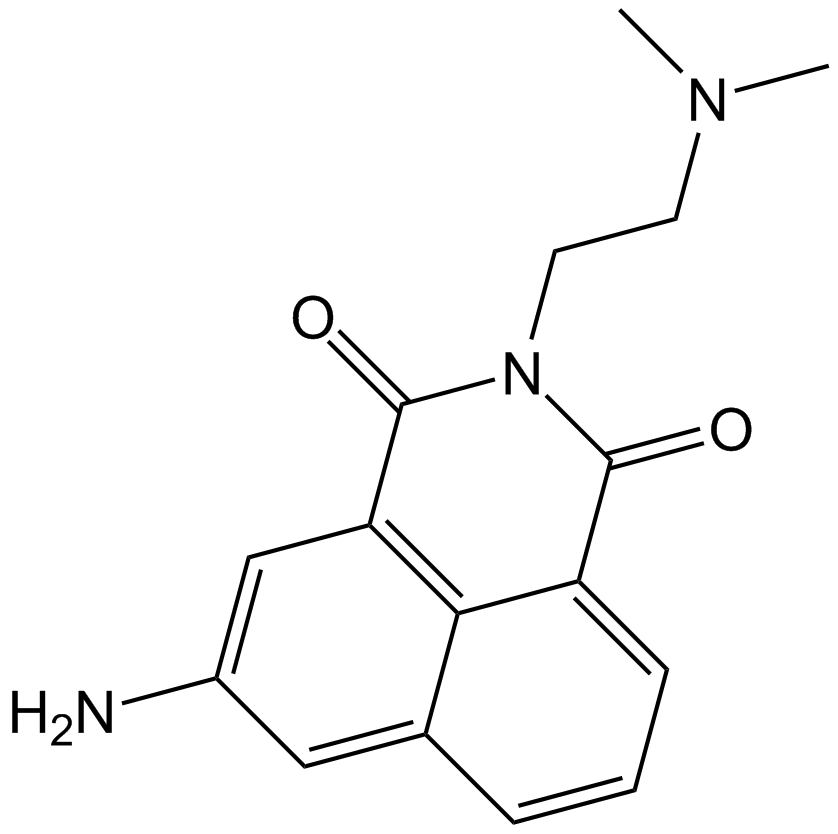Amonafide (Synonyms: AS1413, Benzisoquinolinedione, Nafidimide, NCI 308847, NSC 308847) |
| Catalog No.GC11019 |
DNA intercalator,Topo II inhibitor
Products are for research use only. Not for human use. We do not sell to patients.

Cas No.: 69408-81-7
Sample solution is provided at 25 µL, 10mM.
IC50: 4.67, 2.73, and 6.38 for HT-29, HeLa, and PC3 cells, respectively
Amonafide is a novel topoisomerase II inhibitor. Topoisomerase II plays critical roles including DNA transcription, replication and chromosome segregation. Though the biological functions of topoisomerase II are important for insuring genomic integrity, the ability to interfere with topoisomerase II and generate enzyme mediated DNA damage is an effective strategy for cancer chemotherapy.
In vitro: Amonafide intercalated with DNA and disrupted the loading of topoisomerases. In contrast to the classic agents, amonafide was found to induce higher molecular weight fragmentation, resulting in the apoptosis without DNA cleavage. Amonafide was found to act in an ATP-independent manner and seemed unlikely to induce the chromosome translocations associated with treatmentinduced leukemia [1].
In vivo: Amonafide was found to be able to inhibit IP L1210 leukemia, with optimal increased life spans (ILS) of 61% to 106% following single 16 mg/kg dosing on days 1 to 9. Similar efficacy was noted against IP P388 murine leukemia and the SC implanted L1210 leukemia. Additionally, amonafide demonstrated activity against two nonleukemic IP implanted murine tumors, the M5076 sarcoma and the B16 melanoma [2].
Clinical trial: A multicenter, open-label, combination Phase II study was conducted for patients with sAML, evaluating the efficacy of cytarabine and amonafide administered as a continuous iv. Infusion of cytarabine on days 1-7 combined with 600 mg/m2/day for days 1-5[1].
References:
[1] Freeman CL,Swords R,Giles FJ. Amonafide: a future in treatment of resistant and secondary acute myeloid leukemia Expert Rev Hematol.2012 Feb;5(1):17-26.
[2] Saez R,Craig JB,Kuhn JG,Weiss GR,Koeller J,Phillips J,Havlin K,Harman G,Hardy J,Melink TJ, et al. Phase I clinical investigation of amonafide. J Clin Oncol.1989 Sep;7(9):1351-8.
Cell experiment: | In experiments measuring survival following 1 h drug treatments, 2 × 106cells are resuspended in 2 mL warm (37°C) HBSS with 5% PCS; the appropriate drug (Amonafide) level is attained with the addition of less than 50 μL. Cells are incubated for 60 min at 37°C after which 10 mL ice cold PBS is added. The cells are then centrifuged at 200 × g for 10 min at 4°C. The wash is repeated once and the cells are resuspended in HBSS with 5% PCS and added to the agar-medium mixture for assessment of surviving clonogenic cells[2]. |
References: [1]. Allen SL, et al. Amonafide: a potential role in treating acute myeloid leukemia. Expert Opin Investig Drugs. 2011 Jul;20(7):995-1003. | |
| Cas No. | 69408-81-7 | SDF | |
| Synonyms | AS1413, Benzisoquinolinedione, Nafidimide, NCI 308847, NSC 308847 | ||
| Chemical Name | 5-amino-2-[2-(dimethylamino)ethyl]benzo[de]isoquinoline-1,3-dione | ||
| Canonical SMILES | CN(C)CCN1C(=O)C2=CC=CC3=CC(=CC(=C32)C1=O)N | ||
| Formula | C16H17N3O2 | M.Wt | 283.33 |
| Solubility | ≥ 14.2mg/mL in DMSO | Storage | Store at -20°C |
| General tips | Please select the appropriate solvent to prepare the stock solution according to the
solubility of the product in different solvents; once the solution is prepared, please store it in
separate packages to avoid product failure caused by repeated freezing and thawing.Storage method
and period of the stock solution: When stored at -80°C, please use it within 6 months; when stored
at -20°C, please use it within 1 month. To increase solubility, heat the tube to 37°C and then oscillate in an ultrasonic bath for some time. |
||
| Shipping Condition | Evaluation sample solution: shipped with blue ice. All other sizes available: with RT, or with Blue Ice upon request. | ||
| Prepare stock solution | |||

|
1 mg | 5 mg | 10 mg |
| 1 mM | 3.5295 mL | 17.6473 mL | 35.2945 mL |
| 5 mM | 0.7059 mL | 3.5295 mL | 7.0589 mL |
| 10 mM | 0.3529 mL | 1.7647 mL | 3.5295 mL |
Step 1: Enter information below (Recommended: An additional animal making an allowance for loss during the experiment)
 g
g
 μL
μL

Step 2: Enter the in vivo formulation (This is only the calculator, not formulation. Please contact us first if there is no in vivo formulation at the solubility Section.)
Calculation results:
Working concentration: mg/ml;
Method for preparing DMSO master liquid: mg drug pre-dissolved in μL DMSO ( Master liquid concentration mg/mL, Please contact us first if the concentration exceeds the DMSO solubility of the batch of drug. )
Method for preparing in vivo formulation: Take μL DMSO master liquid, next addμL PEG300, mix and clarify, next addμL Tween 80, mix and clarify, next add μL ddH2O, mix and clarify.
Method for preparing in vivo formulation: Take μL DMSO master liquid, next add μL Corn oil, mix and clarify.
Note: 1. Please make sure the liquid is clear before adding the next solvent.
2. Be sure to add the solvent(s) in order. You must ensure that the solution obtained, in the previous addition, is a clear solution before proceeding to add the next solvent. Physical methods such as vortex, ultrasound or hot water bath can be used to aid dissolving.
3. All of the above co-solvents are available for purchase on the GlpBio website.
Quality Control & SDS
- View current batch:
- Purity: >99.50%
- COA (Certificate Of Analysis)
- SDS (Safety Data Sheet)
- Datasheet
Average Rating: 5 (Based on Reviews and 1 reference(s) in Google Scholar.)
GLPBIO products are for RESEARCH USE ONLY. Please make sure your review or question is research based.
Required fields are marked with *



















